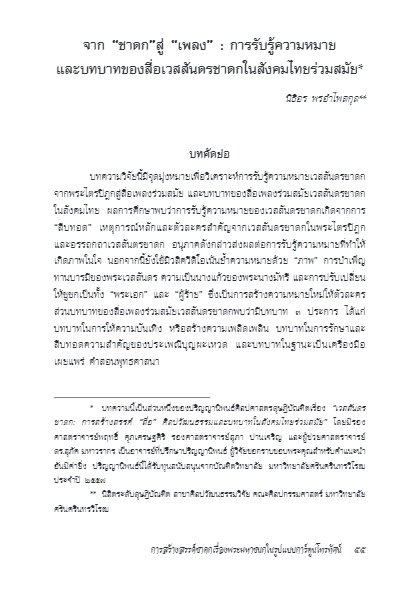นิธิอร พรอำไพสกุล
บทคัดย่อ
บทความวิจัยนี้มีจุดมุ่งหมายเพื่อวิเคราะห์การรับรู้ความหมายเวสสันดรชาดกจากพระไตรปิฎกสู่สื่อเพลงร่วมสมัย และบทบาทของสื่อเพลงร่วมสมัยเวสสันดรชาดกในสังคมไทย ผลการศึกษาพบว่าการรับรู้ความหมายของเวสสันดรชาดกเกิดจากการ “สืบทอด” เหตุการณ์หลักและตัวละครสำคัญจากเวสสันดรชาดกในพระไตรปิฎกและอรรถกถาเวสสันตรชาดก อนุภาคดังกล่าวส่งผลต่อการรับรู้ความหมายที่ทำให้เกิดภาพในใจ นอกจากนี้ยังใช้มิวสิควีดิโอเน้นย้ำความหมายด้วย “ภาพ” การบำเพ็ญทานบารมีของพระเวสสันดร ความเป็นนางแก้ว ของพระนางมัทรี และการปรับเปลี่ยนให้ชูชกเป็นทั้ง “พระเอก” และ “ผู้ร้าย” ซึ่งเป็นการสร้างความหมายใหม่ให้ตัวละคร ส่วนบทบาทของสื่อเพลงร่วมสมัยเวสสันดรชาดกพบว่ามีบทบาท 3 ประการ ได้แก่ บทบาทในการให้ความบันเทิง หรือสร้างความเพลิดเพลิน บทบาทในการรักษา และสืบทอดความสำคัญของประเพณีบุญผะเหวด และบทบาทในฐานะเป็นเครื่องมือเผยแพร่คำสอนพุทธศาสนา
(ตีพิมพ์ใน วารสารไทยศึกษา ปีที่ 10 ฉบับที่ 1 (กุมภาพันธ์ – กรกฎาคม 2557) หน้า 55-87)
From “Jataka” to “Songs”: The Semantic Perception and the roles of media in Thai society
Nition Pornumpaisakul
Abstract
The research study was aimed at analyzing the semantic perception of Vessantara Jataka from Tipitaka to media of contemporary songs and the roles of such media in the Thai society.
Findings showed that the semantic perception of Vessantara Jataka was derived from “inheritance” events and the main characters of Vessantara Jataka in Tipitaka and Atthakatha Vessantara Jataka. The motif resulted in semantic perception bringing about images or pictures in mind. In addition, the use of music video confirmed the meaning through “picture” of merit making of Pra-vessantara and the excellent woman of Maddi. The role of Jujaka representing both hero and villain is a way of constructing new meaning for characters. Regarding the roles of media of contemporary songs, results showed that the media has three roles: to entertain, to keep the whole view of merit-making of Bun Phawet (Buddhist festival celebrated in the fourth month in Isan) and to propagate the teaching of Buddha.
(Published in Journal of Thai Studies Volume 10 Number 1 (February – July 2014) Page 55-87)
บทความ / Full Text : Download
